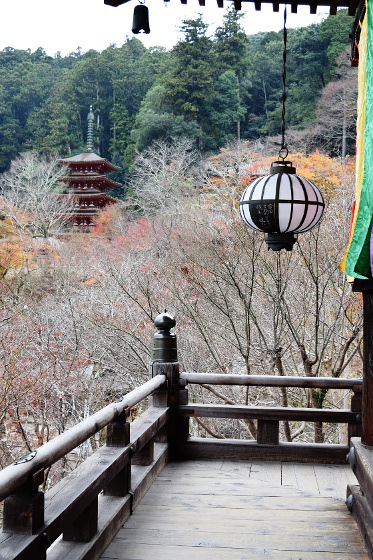I visited Hasedera Temple on December 4, 2016, a rainy day. I had missed the peak autumn colors by about two weeks, but as the video title suggests, Hasedera offers tranquility and stunning views of its covered walkways, buildings, and Buddha statue, regardless of the season.
For travelers on the road, finding a lovely restaurant to rest and relax is a truly rewarding experience. Luckily, on the day of my visit to Hasedera Temple, I stumbled upon a beautiful restaurant in the nearby town area. I would say it was the most beautiful restaurant I had ever visited during my 12-day trip to Japan in December 2016.
Kneeling down on the tatami mats and surrounded by a stunning garden, I decided to reward myself with a local dish called にゅうめん (nyuumen).
Nyuumen is a type of somen noodles from Miwa, Japan. They are thin as a thread and white as snow. They are eaten with seasonal vegetables in both summer and winter. In summer, they are eaten cold, and in winter, they are eaten in warm broth.
My order also came with kaki no hazushi (かきの葉ずし or 柿の葉すし), which is made with rice seasoned with vinegar and topped with slices of salmon or salted mackerel. The mackerel used in this dish is prepared according to a special secret method, which is why kaki no hazushi is only available in Nara.
Nice Restaurant in Town Area
For travelers on the road, finding a lovely restaurant to rest and relax is a truly rewarding experience. Luckily, on the day of my visit to Hasedera Temple, I stumbled upon a beautiful restaurant in the nearby town area. I would say it was the most beautiful restaurant I had ever visited during my 12-day trip to Japan in December 2016.
Kneeling down on the tatami mats and surrounded by a stunning garden, I decided to reward myself with a local dish called にゅうめん (nyuumen).
Nyuumen is a type of somen noodles from Miwa, Japan. They are thin as a thread and white as snow. They are eaten with seasonal vegetables in both summer and winter. In summer, they are eaten cold, and in winter, they are eaten in warm broth.
My order also came with kaki no hazushi (かきの葉ずし or 柿の葉すし), which is made with rice seasoned with vinegar and topped with slices of salmon or salted mackerel. The mackerel used in this dish is prepared according to a special secret method, which is why kaki no hazushi is only available in Nara.
Finally, I ordered a Japanese sake to warm up on that cold rainy day. I fell in love with sake after tasting it for the first time on Koyasan.[5,6] It has a sweet taste and a fragrant aroma, and best of all, it didn't give me a hangover the next day.
 |
| にゅうめん (nyuumen) and 柿の葉すし (かきの葉ずし / kaki no hazushi) |
References
- Nara: Tranquil temples and bountiful blooms (video)
- Sekko-ji temple (石光寺)
- Taima-dera (當麻寺)
- Chōgaku-ji Temple (長岳寺)
- Hase-dera Temple (総本山長谷寺)
- Hase-dera (総本山長谷寺)
- Hase-dera (TripAdvisor)
- Japan Travel: Eating in Nara (奈良) (Travel for a Purpose)
- Japan: Temple Lodging at Mount Koya (or Koyasan 高野山) (Travel for a Purpose)
- Temple Lodging in Koyasan—Personal Experience (Travel for a Purpose)











No comments:
Post a Comment
Note: Only a member of this blog may post a comment.